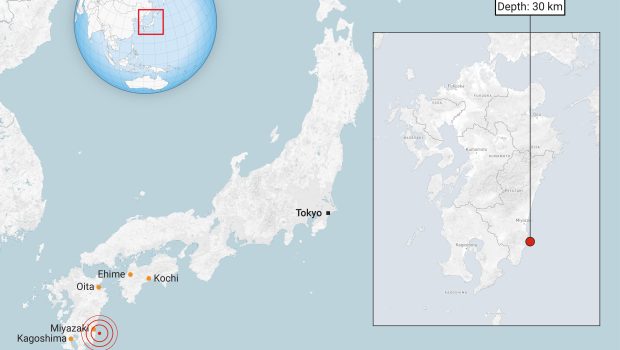Japan Issues First-Ever Megaquake Advisory Following 7.1 Quake

The 7.1 quake struck off the southeastern coast of Japan’s southern main island of Kyushu.
Local and national government bodies in Japan took the initiative by issuing a temporary tsunami advisory and the first-ever “megaquake advisory” last week after a powerful quake occurred about 12 miles southeast of Miyazaki, a city on the island of Kyushu.
On Thursday, Aug. 8, the notable quake registered a magnitude of 7.1, according to the USGS.
The quake caused no deaths or severe damage, but the advisory issued by the Japan Meteorological Agency has led to widespread confusion and a lingering sense of worry—even in a country well accustomed to regular quakes. (Japan lies on the Ring of Fire, an area of intense seismic and volcanic activity on both sides of the Pacific Ocean.)
“Japan sits on the boundaries of four tectonic plates, which makes it one of the most earthquake-prone areas in the world,” said Shoichi Yoshioka, a professor at Japan’s Kobe University. “About 10% of the world’s earthquakes of magnitude 6 or higher occur in or around Japan, so the risk is much higher than in places like Europe or the eastern United States, where earthquakes are rare,” Yoshioka added.
A 7.1 magnitude earthquake has hit Japan pic.twitter.com/Mem7tavRn4
— Jujutsu Kaisen (@JujutsuTwts) August 9, 2024
With the first “megaquake advisory” it has ever issued, the agency stated that the risk of strong shaking and a tsunami is greater than usual along the Nankai Trough, a subduction zone with the potential to produce magnitude 8 or 9 temblors.
The possibility that the quake—which occurred at 4:43 p.m. local time (12:43 a.m. EST)—was a foreshock for a larger earthquake is always a concern, but it becomes less likely with every hour that passes, said Ole Kaven, a USGS research geophysicist.
“The rule of thumb is that there’s a 5% chance of an event larger than the main shock happening, and that probability will decrease the more time that passes,” he said.
Harold Tobin, a University of Washington professor who has studied the Nankai Trough, noted that the magnitude-7.1 quake took place in a segment that shakes more frequently than others. Regular earthquakes can relieve stress, so the possibility that this segment itself will produce a big earthquake is less of a concern.
The worst quake in recent Japanese history was the 9.1 magnitude Tohoku earthquake in 2011 which triggered a major tsunami and nuclear disaster. About 20,000 people were killed.